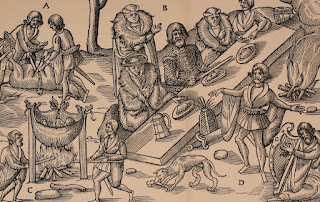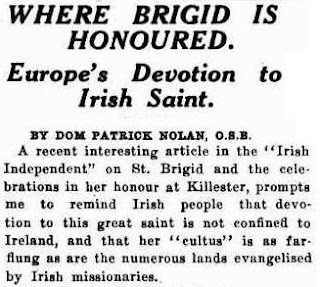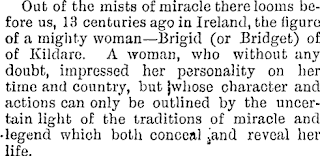We conclude the series of posts in honour of Saint Brigid with a look at the history of the relic of her mantle, preserved at the Cathedral de Saint Sauveur in Bruges. In the previous post we looked at what the examinations of 1866 and 1935 revealed about the nature of the relic, as described by Henry McClintock. But what of its origins? How did la manteline de Saint Brigide d'Irlande come to Belgium? Let's start with a brief reminder of how the relic is displayed today:
What the visitor actually sees is a glazed frame of Gothic design, not unlike the fame of a picture, and underneath the glass, an ancient and, much worn, piece of cloth, roughly two feet square, of a dull crimson colour and of a strange make quite unlike any modern cloth with which we are now familiar. Its surface instead of being smooth is covered all over with tufts of curly wool so that at first sight it looks more like a piece of sheep skin's or astrakhan fur dyed red than any sort of fabric woven on the loom.
Next, McClintock sketches the interesting provenance of this relic which goes back to the Saxon royal house:
The history of this piece of cloth is as strange and romantic as its appearance. It is said to have been brought to Bruges and presented to the Cathedral by the Princess Gunhild of England, a sister of King Harold, who took refuge there after the defeat and death of her brother, as well as that of her husband, at the battle of Hastings, 1066. The first documentary record of the relic is in the year 1347, and this earlier part of its history rests only on tradition, but there is no reason to doubt its truth and indeed there is much to confirm it. It is, for instance, a historical fact that Princess Gunhild settled in Bruges after the battle of Hastings and ultimately died there twenty-one years later; while the story is further supported by the fact that there was as close connection between her family and Ireland, for when her father, Earl Godwine, then the wealthiest and most powerful man in England, quarrelled with the King - King Edward the Confessor - in the year 1051 and was exiled to Flanders, two of his sons, Harold and Leofwine, went to Ireland where they stayed with the King of Leinster, Diarmaid Mac Mael-na-mbo, and busied themselves in collecting ships and men to help their father in gaining his restoration. Having thus raised a force they set sail for the English Channel and joined Godwine who had come with auxiliaries from Flanders, and the two fleets proceeded together along the south coast of England taking hostages and receiving promises of help and thence up the Thames to London where, at a conference with the King, matters were settled and Godwine was allowed to return and his property was restored. Now nothing could have been more likely, or more in keeping with the spirit of those days, than for the the two young princes, before embarking on a desperate adventure like this to have visited a famous shrine like that of St Brigid at Kildare in the heart of Diarmaid's kingdom, and to have returned with a relic of the saint in memory of their pilgrimage. This relic would have been carried with them during their subsequent successful expedition and would thenceforward have become one of the most treasured possessions of their family. It would, therefore, be only natural for their sister to rescue it with her other valuable possessions and to take it with her for safety to Flanders.Sadly, the author declines to devote much time to the later history but nevertheless manages to include some interesting details, especially of how the relic was used for healing:
I will pass over the subsequent history of the relic - how about the year 1400, it was enclosed in a sumptuous covering of yellow silk and gold lace in the form of a cape, which used to be placed on the shoulders of the sick, and especially those of sick women, and was exposed for veneration of the 1st of February in each year; how it, together with other Church valuables, was preserved and placed in safety when the the Cathedral was destroyed during the French revolution....McClintock, H. F. (1951). The “Mantle of Saint Brigid” at Bruges. Journal of the County Louth Archaeological Society, 12 (3), 119–122. https://doi.org/10.2307/27728777
As this is the Octave Day of the Feast of Saint Brigid I will close with the traditional prayer from her Office:
Deus, qui nos hodierna die beatae Brigidae Virginis tuae annua solemnite laetificas: concede propitius; ut ejus adjuvemur meritis, cujus castitatis irradiamur exemplis. Per Dominum.
O GOD, Who year by year dost cause us to rejoice as upon this day, in the feast of Thy blessed hand-maiden Brigid, mercifully grant us help for her sake, the bright ensample of whose chastity doth still shed its light upon us. Through our Lord Jesus Christ Thy Son, Who liveth and reigneth with Thee, in the unity of the Holy Ghost, one God, world without end. Amen.
Content Copyright © Trias Thaumaturga 2012-2022. All rights reserved.








